HESI Final Exam with Complete Solutions
Document Content and Description Below
An older client is admitted with a diagnosis of bacterial pneumonia. Which symptom should the nurse report to the HCP after assessing the client? A)Leukocytosis and febrile. B) Polycythemia and cr... ackles. C) Pharyngitis and sputum production. D) Confusion and tachycardia. - ANSWER D. The onset of Pneumonia in the older client may be signaled by general deterioration, confusion, increased HR, and/or increased respirations. A, B, and C are often absent in the older client with bacterial pneumonia. The nurse is reviewing routine medications taken by a client with chronic angle closure glaucoma. Which medication prescription should the nurse question? A) Antianginal with a therapeutic effect of vasodilation. B) Anticholinergic with a side effect of pupillary dilation. C) Antihistamine with a side effect of sedation. D) Corticosteroid with a side effect of hyperglycemia. - ANSWER B. Clients with angle-closure glaucoma should not take medications that dilate the pupil because they can precipitate acute and severely increased IOP. A, C, and D do not cause increased IOP, which is the primary concern with angle-closure glaucoma. The nurse is caring for a critically ill client with cirrhosis of the liver who has a NG tube draining bright red blood. The nurse notes that the client's serum hemoglobin and hematocrit levels are decreased. Which additional change in laboratory data should the nurse expect? A) Increased serum albumin level. B) Decreased serum creatinine. C) Decreased serum ammonia level. D) Increased liver function test results. - ANSWER C. The breakdown of glutamine in the intestine and the increased activity of colonic bacteria from the digestion of proteins increase ammonia levels in clients with advanced liver disease, so removal of blood, a protein source, from the intestine results in a reduced level of ammonia. A, B, and D will not be significantly affected by the removal of blood. A resident in a long-term care facility is diagnosed with Hep B. Which intervention should the nurse implement with the staff caring for this client? A) Determine if all employees have had the Hep B vaccine series. B) Explain that this type of hepatitis can be transmitted when feeding the client. C) Assure the employees that they cannot contract Hep B when providing direct care. D) Tell the employees that wearing gloves and a gown are required when providing care. - ANSWER A. Hep B vaccine should be administered to all health care providers. Hep A (not Hep B) can be transmitted by fecal-oral contamination. There is a chance that staff could contract Hep B if exposed to the client's blood and/or body fluids, therefore C is incorrect. There is no need to wear gloves and gowns except with blood or body fluid contact. A client with HTN has been receiving ramipril (altace), 5mg, PO, daily for 2 weeks and is scheduled to receive a dose at 0900. At 0830, the client's blood pressure is 120/70. Which action should the nurse take? A) Administer the prescribed dose at the scheduled time. B) Hold the dose and contact the HCP. C) Hold the dose and recheck the BP in 1 hour. D) Check with the HCP's prescription to clarify dose. - ANSWER A. The client's BP is within normal limits, indicating that the ramipril, an antihypertensive, is having the desired effect and should be administered. B and C would be appropriate if the client's BP was excessively low (<100 systolic) or if the client were exhibiting signs of hypotension such as dizziness. The nurse assesses a client who has been prescribed furosemide (Lasix) for cardiac disease. Which ECG change would be a concern for a client taking a diuretic? A) Tall, spiked T waves. B) A prolonged QT interval. C) A widening QRS complex. D) Presence of a U wave. - ANSWER D. A U wave is a positive deflection following the T wave and is often present with hypokalemia. A, B and C are all signs of hyperkalemia. A client diagnosed with chronic kidney disease (CKD) 2 years ago is regularly treated at a community hemodialysis facility. Before his scheduled dialysis treatment, which electrolyte imbalance should the nurse anticipate? A) Hypophosphatemia. B) Hypocalcemia. C) Hyponatremia. D) Hypokalemia - ANSWER B. Hypocalcemia develops in CKD because of chronic hyperphosphatemia. Increased phosphate levels cause the peripheral deposition of calcium and resistance to vitamin D absorption needed for calcium absorption. Prior to dialysis, the nurse would expect to find the client hypernatremic and hyperkalemic, not with C or D. The home health nurse is assessing a male client being treated for Parkinson's disease with Sinemet. The nurse observes that he does not demonstrate any apparent emotion when speaking and rarely blinks. Which intervention should the nurse implement? A) Perform a complete cranial nerve assessment. B) Instruct the client that he may be experiencing medication toxicity. C) Document the presence of these assessment findings. D) Advise the client to seek immediate medical evaluation. - ANSWER C. A masklike expression and infrequent blinking are common clinical features of parkinsonism. The nurse should document these expected findings. Signs of toxicity of Sinemet include dyskinesia, hallucinations, and psychosis. A client with CHF and Afib develops ventricular ectopy with a pattern of 8 ectopic beats/min. Which action should the nurse take based on this observation? A) Assess for bilateral jugular vein distention. B) Increase oxygen flow via nasal cannula. C) Administer PRN Lasix. D) Auscultate for a pleural friction rub. - ANSWER B. The client should have the oxygen flow immediately increased to promote oxygenation of the myocardium. Ventricular ectopy, characterized by multiple PVCs, is often caused by myocardial ischemia exacerbated by hypokalemia. During the change of shift report, the charge nurse reviews the infusions being received by clients on the oncology unit. The client receiving which infusion should be assessed first? A) Continuous IV infusion of magnesium. B) One-time infusion of albumin. C) Continuous epidural infusion of morphine. D) Intermittent infusion of IV vancomycin. - ANSWER C. All four of these clients have a potential to have significant complications. The client with the morphine epidural infusion is at highest risk for respiratory depression and should be assessed first. A 25-year-old client was admitted yesterday after a motor vehicle collision. Neurodiagnostic studies have shown a basal skull fracture in the middle fossa. Assessment on admission revealed both halo and battle signs. Which new symtom indicates that the client is likely to be experiencing a common life-threatening complication associated with a basal skull fracture? A) Bilateral jugular vein distension. B) Oral temp of 102. C) Intermittent focal motor seizures. D) Intractable pain in the cervical region. - ANSWER B. Clients with basilar skull fractures are at high risk for infection of the brain, as indicated by an increased oral temp because the fracture leaves the meninges open to bacterial invasion. The nurse is observing a UAP performing morning care for a bedridden client with Huntington's disease. Which care measure is most important for the nurse to supervise? A) Oral care. B) Bathing. C) Foot care. D) Catheter care. - ANSWER A. The client with Huntington's disease experiences problems with motor skills such as swallowing and is at high risk for aspiration. B, C, and D do not necessarily require RN supervision because they do not ordinarily post life-threatening consequences. A family member was taught to suction a client's tracheostomy prior to the client's discharge from the hospital. Which observation by the nurse indicates that the family member is capable of correctly performing the suctioning technique? A) Turns on the continuous wall suction to -190 mm Hg. B) Inserts the catheter until resistance or coughing occurs. C) Withdraws the catheter while maintaining suctioning. D) Reclears the tracheostomy after suctioning the mouth. - ANSWER B. Indicates correct technique for performing suctioning. Suction pressure should be between -80 and -120 mm Hg, not -190 mm Hg. The catheter should be withdrawn 1-2 cm at a time with intermittent, not continuous suction. D introduces pathogens unnecessarily into the tracheobronchial tree. Which nursing action is necessary for the client with a flail chest? A) Withhold prescribed analgesic medications. B) Percuss the fractured rib area with light taps. C) Avoid implementing pulmonary suctioning. D) Encourage coughing and deep breathing. - ANSWER D. Treatment of flail chest is focused on preventing atelectasis and related complications of compromised ventilation by encouraging coughing and deep breathing. C should not be avoided because suctioning is necessary to maintain pulmonary toilet in clients who require mechanical ventilation. A should not be withheld. B should not be applied because the fractures are clearly visible on the chest radiograph. The nurse is completing an admission interview for a client with Parkinson's disease. Which question will provide additional information about manifestations that the client is likely to experience? A) "Have you ever experienced any paralysis of your arms or legs?" B) "Do you have frequent blackout spells?" C) "Have you ever been frozen in one spot, unable to move?" D) "Do you have headaches, especially ones with throbbing pain?" - ANSWER C. Clients with parkinson's disease frequently experience difficulty in initiating, maintaining, and performing motor activities. They may even experience being rooted to the spot and unable to move. Parkinson's disease does not typically cause A, B, or D. The nurse is assessing a 75-year-old client for symptoms of hyperglycemia. Which symptom is an older adult most likely to exhibit? A) Polyuria. B) Polydipsia. C) Weight loss. D) Infection. - ANSWER D. S/s of hyperglycemia in older adults may include fatigue, infection and evidence of neuropathy. The nurse needs to remember that classic s/s of hyperglycemia such as A, B, and C and polyphagia, may be absent in older adults. One day after a Billroth 2 surgery, a male client suddenly grabs his right chest and becomes pale and diaphoretic. Vital signs are assessed as BP 100/80, pulse 100, and respirations 36. Which action is most important for the nurse to take? A) Provide a paper bag for his hyperventilation. B) Administer a prescribed PRN analgesic. C) Have the client drink a glass of sweetened fruit juice. D) Apply oxygen at 2L via nasal cannula. - ANSWER D. Pulmonary embolism and pneumothorax are risks associated with major abdominal surgery. The nurse should immediately provide oxygen while performing further assessment. A rapid respiratory rate should not be treated as hyperventilation. A client with chronic asthma is admitted to the PACU complaining of pain at a level of 8 on a 1-10 scale, with a BP os 127/78, pulse of 88, and respirations of 20. The PACU recovery prescription is "Morphine, 2-4 mg IV pulse, while recovering for pain level over 5." Which intervention should the nurse implement? A) Give the medication as prescribed to decrease the client's pain. B) Call the anesthesia provider for a different medication for pain. C) Use nonpharmacologic techniques before giving the medication. D) Reassess the pain level in 30 minutes and medicate if it remains elevated. - ANSWER B. The nurse should call the provider for a different medication because morphine is a histamine-releasing opioid and should be avoided when the client has asthma. A is unsafe because it puse the client at risk for an asthma exacerbation. Even if the drug were safe for the client, C and D both disregard the prescription and the client's need for pain relief in the immediate postoperative period. A 55-year-old male client has been admitted to the hospital with a medical diagnosis of COPD. Which risk factor is the most significant in the development of this client's COPD? A) The client's father was diagnosed with COPD in his 50's. B) A close family member contracted TB last year. C) The client smokes one to two packs of cigarettes per day. D) The client has been 40 pounds overweight for 15 years. - ANSWER C. Smoking, considered to be a modifiable risk factor, is the most significant risk factor for the development of COPD. The exact mechanism of genetic and hereditary implications for the development of COPD is still under investigation. A client is admitted to the hospital with a diagnosis of severe acute diverticulitis. Which nursing intervention has the highest priority? A) Place the client on NPO status. B) Assess the client's temp C) Obtain a stool specimen. D) Administer IV fluids. - ANSWER A. A client with severe acute diverticulitis is at risk for peritonitis and intestinal obstruction and should be made NPO to reduce risk of intestinal rupture. A client on telemetry has a pattern of uncontrolled atrial fibrillation with a rapid ventricular response. Based on this finding, the nurse anticipates assisting the physician with which treatment? A) Administer lidocaine, 75mg IV push. B) Perform synchronized cardioversion. C) Defibrillate the client as soon as possible. D) Administer atropine, 0.4 mg IV push. - ANSWER C. With uncontrolled atrial fibrillation, the treatment of choice is synchronized cardioversion to convert the cardiac rhythm back to normal sinus rhythm. A is a medication used for ventricular dysrhythmias. C is not for a client with atrial fibrillation; it is reserved for clients with life-threatening dysrhythmias, such as ventricular fibrillation and unstable ventricular tachycardia. D is the drug of choice in symptomatic sinus bradycardia, not atrial fibrillation. A female client with an NG tube attached to low suction states that she is nauseated. The nurse assesses that there has been no drainage through the NG tube in the last 2 hours. Which action should the nurse take? A) Irrigate the NG tube with sterile normal saline. B) Reposition the client on her side. C) Advance the NG tube 5cm. D) Administer an IV antiemetic as prescribed. - ANSWER B. The immediate priority is to determine if the tube is functioning correctly, which would then relieve the client's nausea. The least invasive intervention, repositioning the client, should be attempted first followed by the others. Which change in lab values indicates to the nurse that a client with rheumatoid arthritis may be experiencing an adverse effect of methotrexate (Mexate) therapy? A) Increase in rheumatoid factor. B) Decrease in hemoglobin level. C) Increase in blood glucose level. D) Decrease in erythrocyte sedimentation rate (ESR; sed rate) - ANSWER B. Methotrexate is an immunosuppressant. A common side effect is bone marrow depression, which would be reflected [Show More]
Last updated: 1 year ago
Preview 1 out of 28 pages
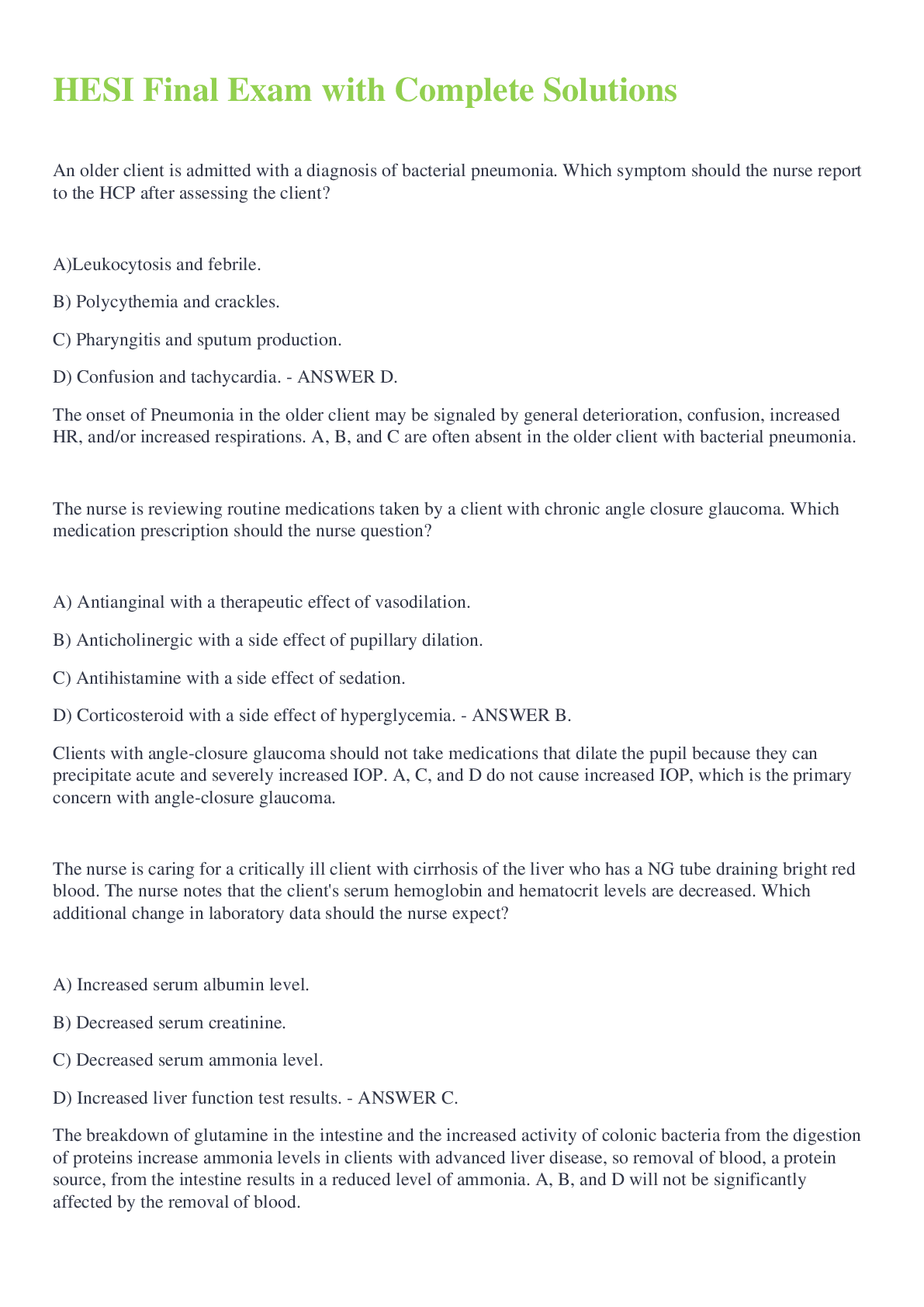
Reviews( 0 )
Recommended For You
*NURSING> HESI > Critical Care HESI exam with complete questions (All)

Critical Care HESI exam with complete questions
Critical Care HESI exam with complete questions
By klaus , Uploaded: Jul 21, 2021
$14
*NURSING> HESI > 2021 PN Hesi Exit Exam With Complete Solution Guide. Graded A. (All)

2021 PN Hesi Exit Exam With Complete Solution Guide. Graded A.
1) The LPN/LVN is preparing to ambulate a postoperative client after cardiac surgery. The nurse plans to do which to enable the client to best tolerate the ambulation? 1. Provide the client with a...
By Georgemm , Uploaded: May 13, 2021
$18
*NURSING> HESI > HESI A2 EXAM WITH COMPLETE QUESTIONS AND ANSWERS, GRADED A+ (All)
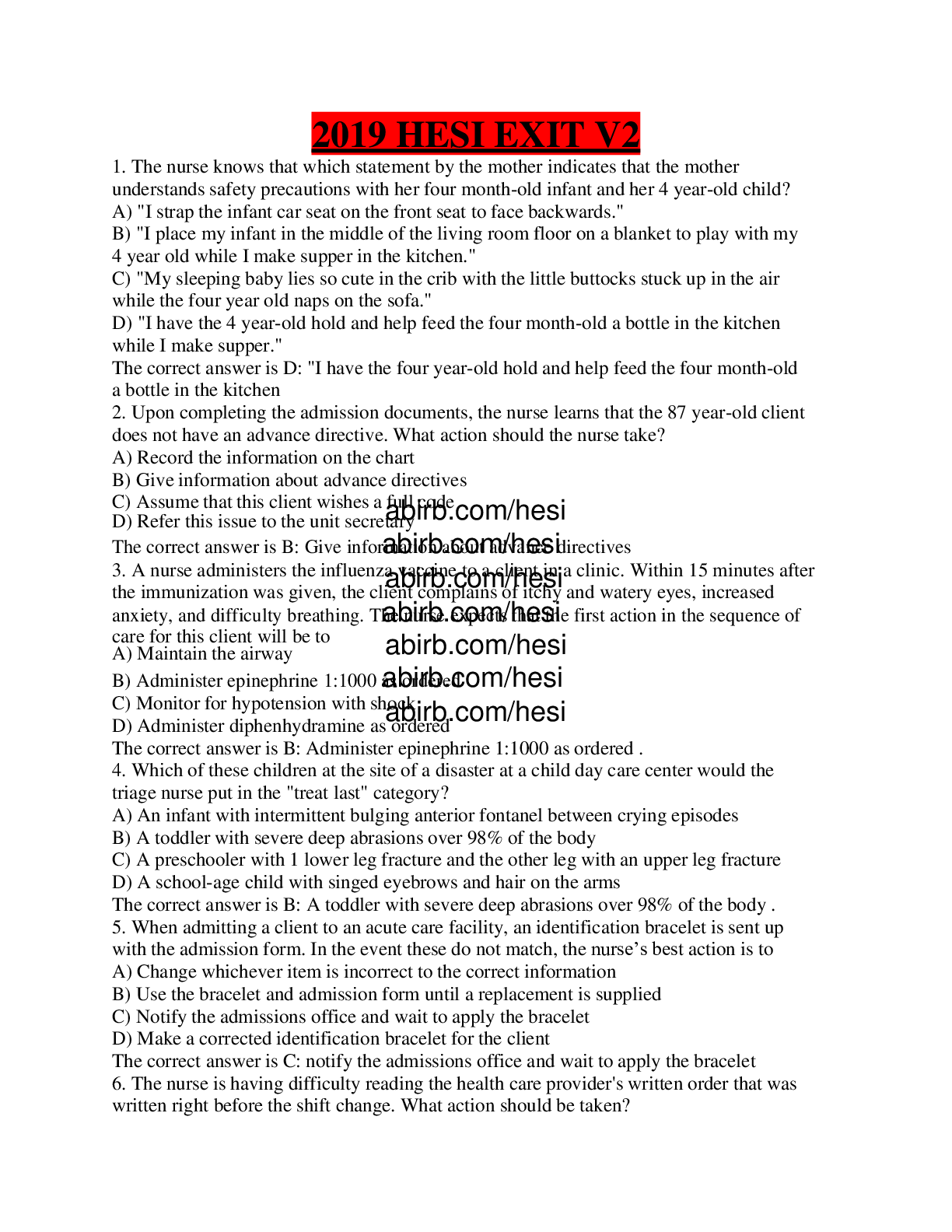
HESI A2 EXAM WITH COMPLETE QUESTIONS AND ANSWERS, GRADED A+
HESI A2 EXAM WITH COMPLETE QUESTIONS AND ANSWERS, GRADED A+ er understands safety precautions with her four month-old infant and her 4 year-old child? A) "I strap the infant car seat on the front...
By VERIFIED A+ , Uploaded: Apr 02, 2021
$12
Medicine> HESI > Hesi Fundamentals Practice Exam with complete Solution (All)
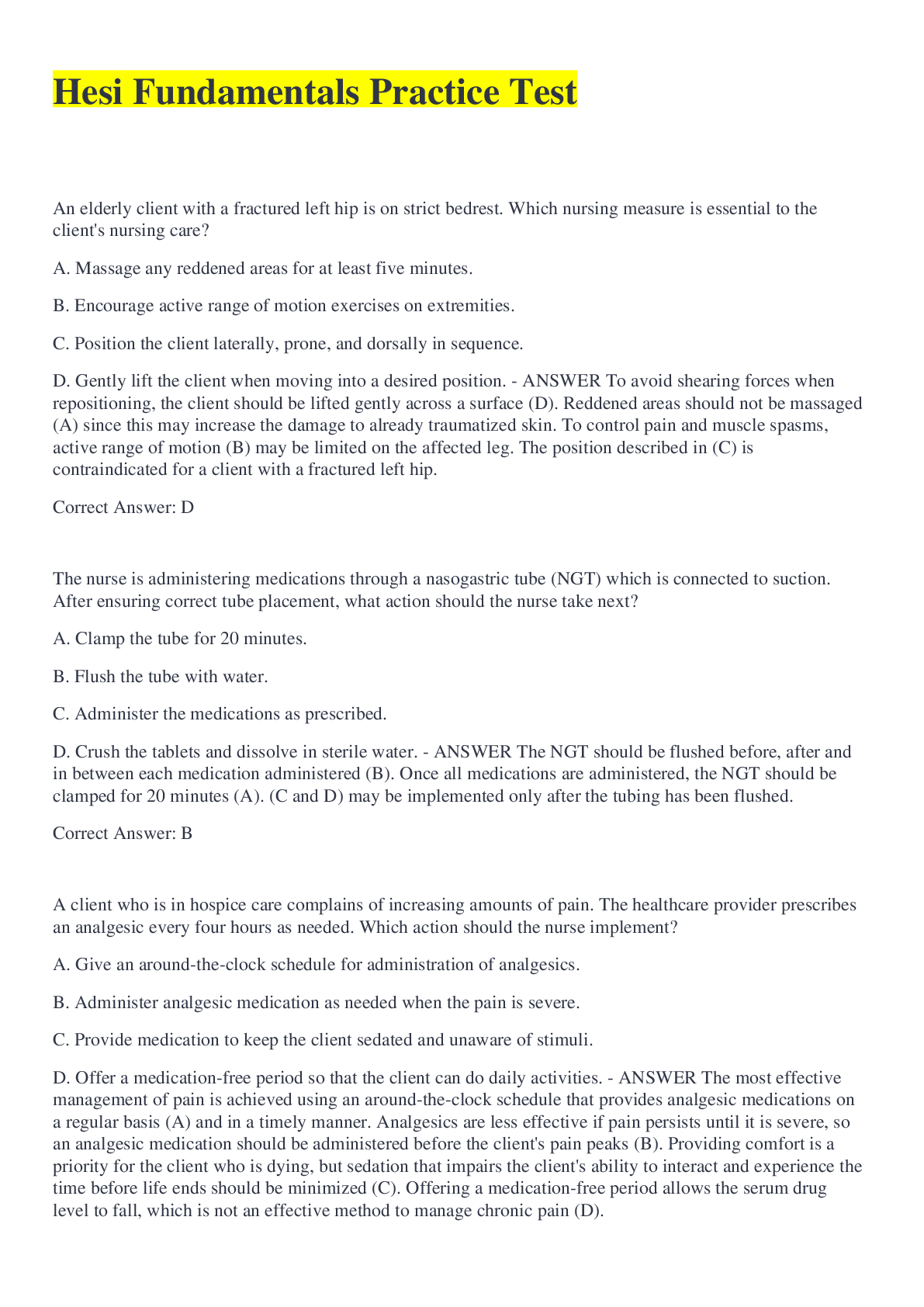
Hesi Fundamentals Practice Exam with complete Solution
An elderly client with a fractured left hip is on strict bedrest. Which nursing measure is essential to the client's nursing care? A. Massage any reddened areas for at least five minutes. B. Encour...
By CATE NATALIA , Uploaded: Aug 24, 2022
$7
Health Care> HESI > Hesi Exit Version 3 2022 Exam with complete solutions (All)
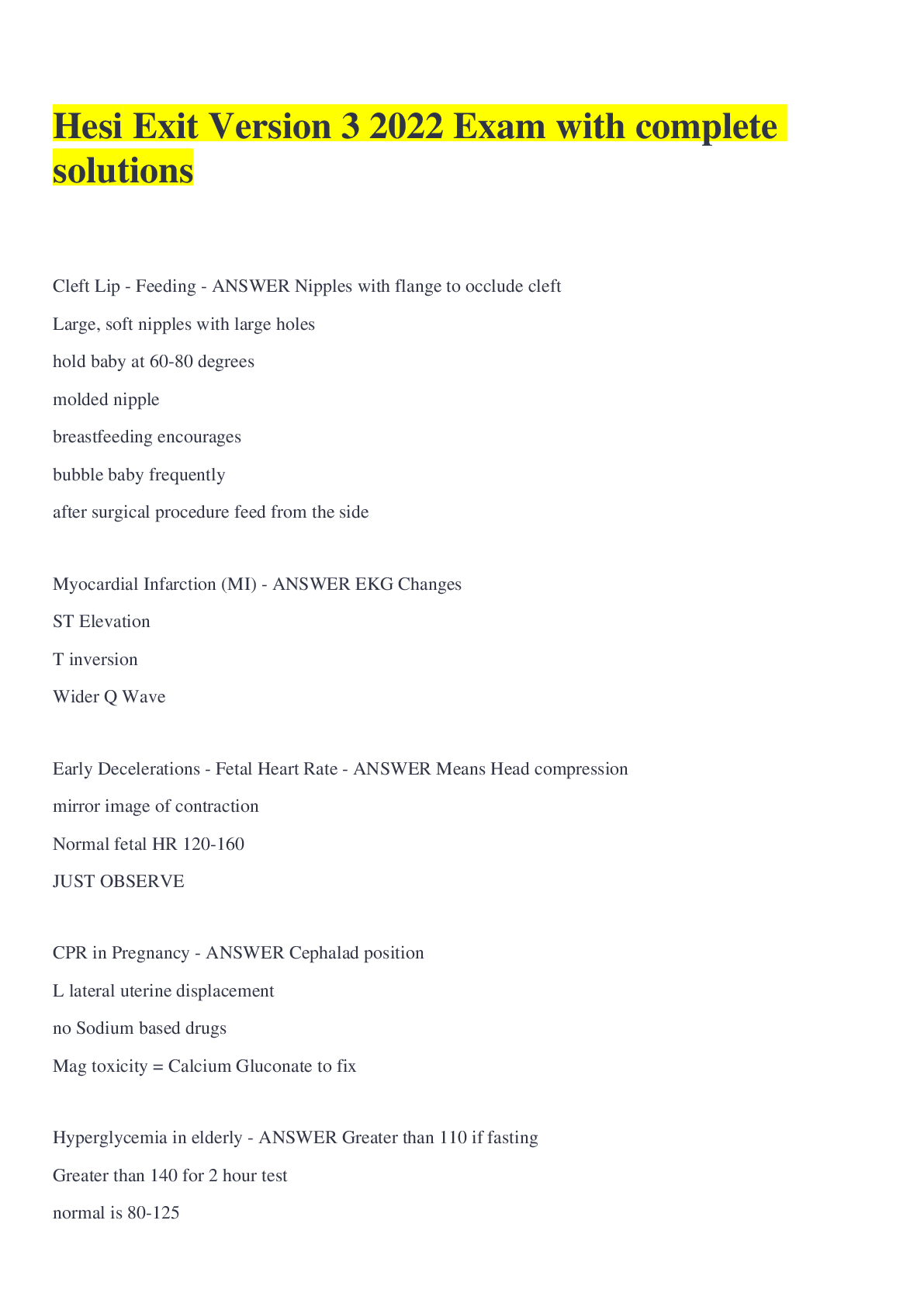
Hesi Exit Version 3 2022 Exam with complete solutions
Cleft Lip - Feeding - ANSWER Nipples with flange to occlude cleft Large, soft nipples with large holes hold baby at 60-80 degrees molded nipple breastfeeding encourages bubble baby frequently af...
By Nancylect , Uploaded: Oct 03, 2022
$6
Health Care> HESI > Hesi Exit Version 3 2022 Exam with complete solutions (All)

Hesi Exit Version 3 2022 Exam with complete solutions
Cleft Lip - Feeding - ANSWER Nipples with flange to occlude cleft Large, soft nipples with large holes hold baby at 60-80 degrees molded nipple breastfeeding encourages bubble baby frequently af...
By MARKALLAN , Uploaded: Oct 03, 2022
$6
Medicine> HESI > HESI Geriatrics Final Exam with Complete Solution (All)
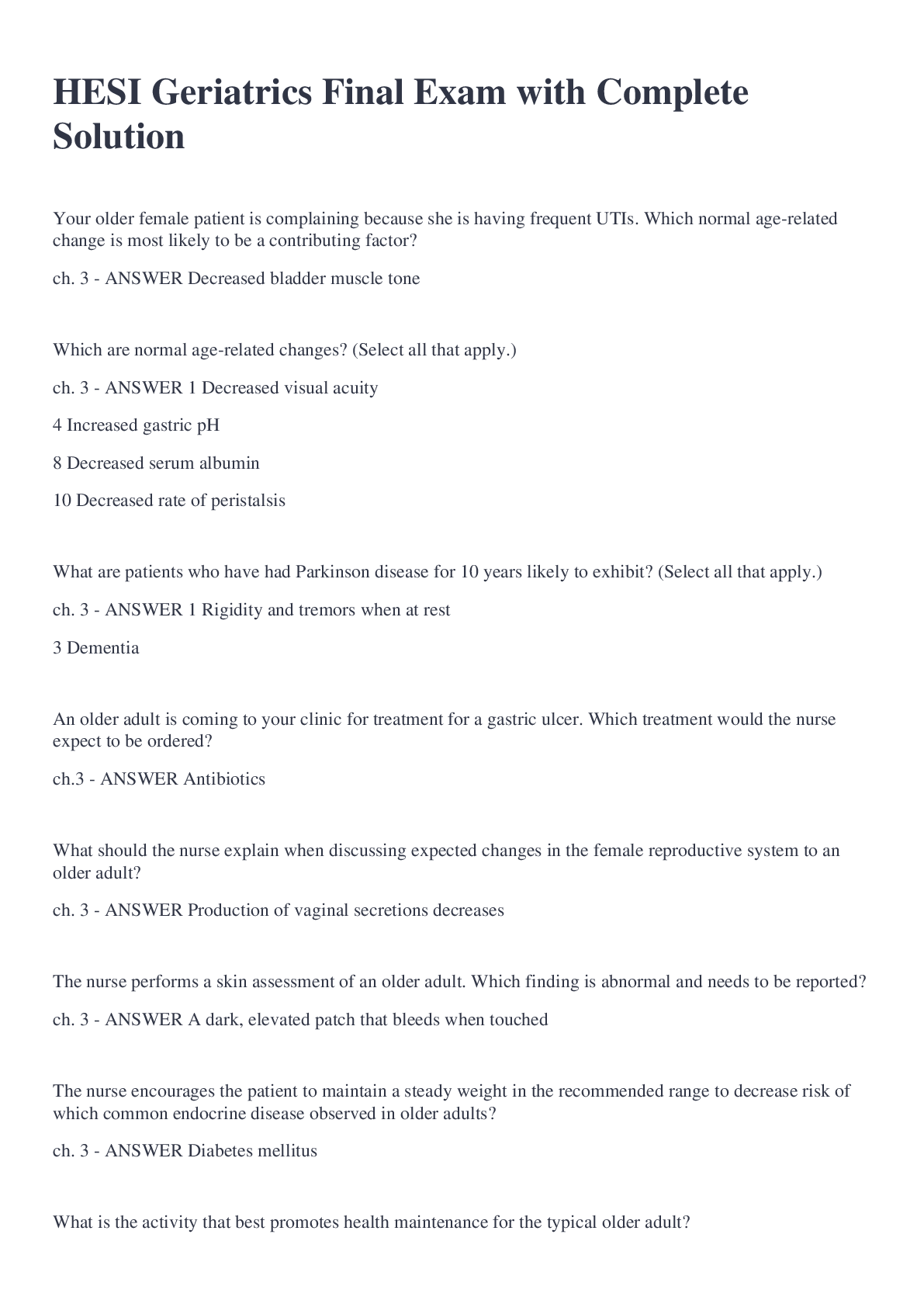
HESI Geriatrics Final Exam with Complete Solution
Your older female patient is complaining because she is having frequent UTIs. Which normal age-related change is most likely to be a contributing factor? ch. 3 - ANSWER Decreased bladder muscle tone...
By CATE NATALIA , Uploaded: Nov 05, 2022
$6
*NURSING> HESI > HESI PN COMPREHENSIVE PREDICTOR EXAM with complete solutions | 2022/2022 (All)
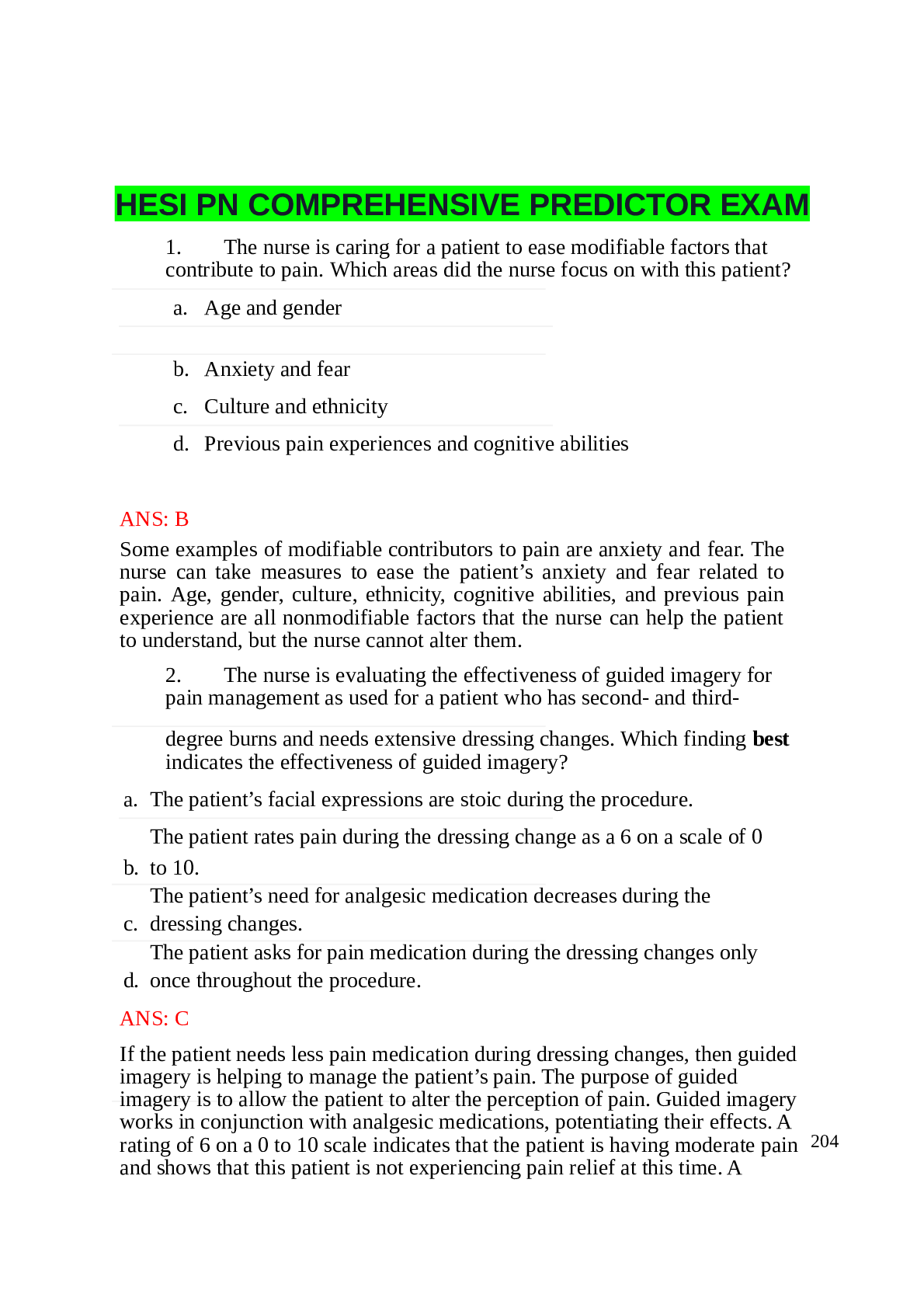
HESI PN COMPREHENSIVE PREDICTOR EXAM with complete solutions | 2022/2022
HESI PN COMPREHENSIVE PREDICTOR EXAM 1. The nurse is caring for a patient to ease modifiable factors that contribute to pain. Which areas did the nurse focus on with this patient? a. Age and gender...
By Dr Medina Reed , Uploaded: Jan 20, 2023
$11
General Questions> HESI > Hesi Exit Exam With Complete Solutions (All)
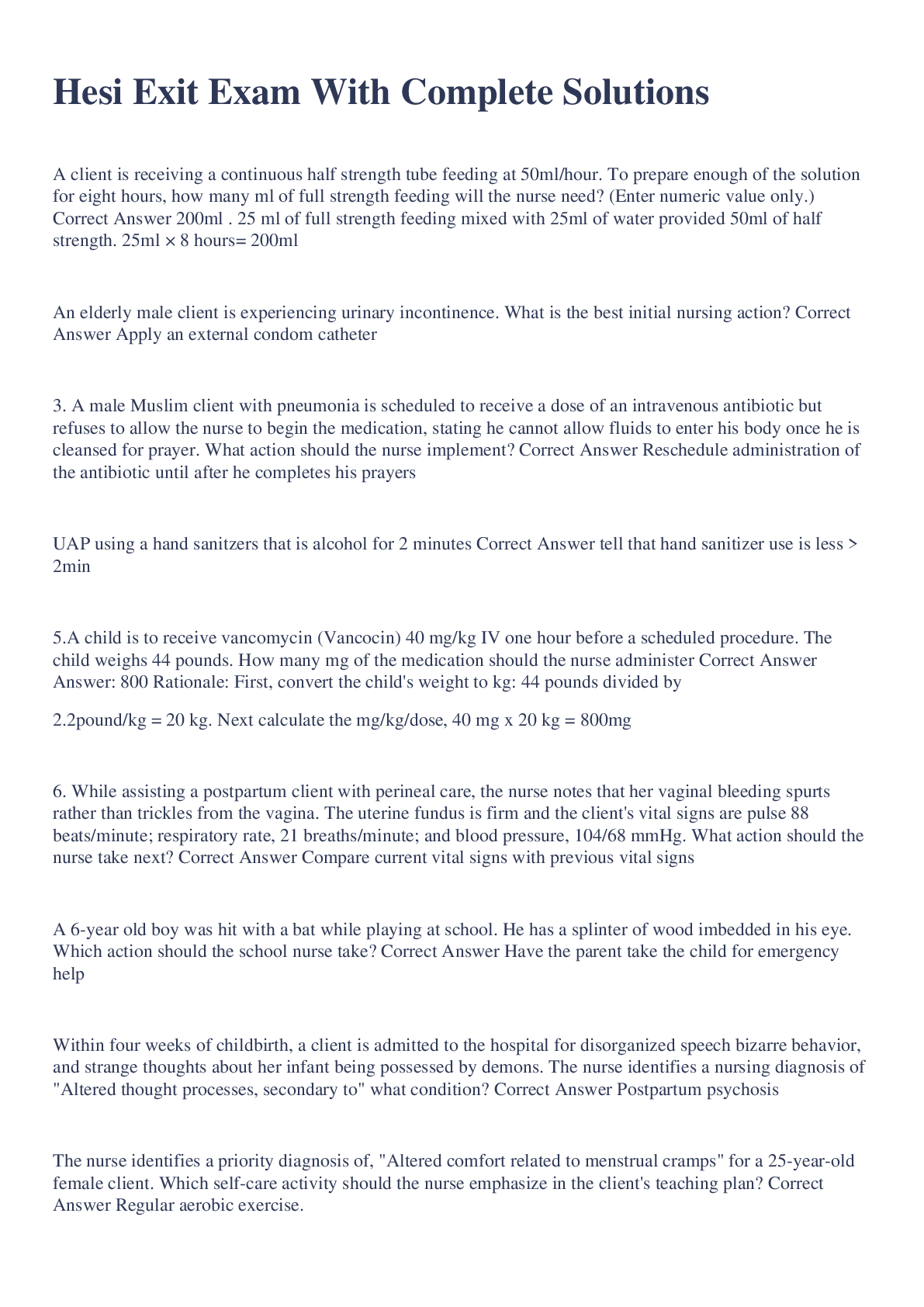
Hesi Exit Exam With Complete Solutions
A client is receiving a continuous half strength tube feeding at 50ml/hour. To prepare enough of the solution for eight hours, how many ml of full strength feeding will the nurse need? (Enter numeric...
By Mabuka , Uploaded: Mar 29, 2023
$10
Health Care> HESI > MED SURG HESI 2022 Exam With Complete Solution (All)

MED SURG HESI 2022 Exam With Complete Solution
MED SURG HESI 2022 Exam With Complete Solution
By Academic mines , Uploaded: Apr 27, 2023
$10
Document information
Connected school, study & course
About the document
Uploaded On
Nov 29, 2022
Number of pages
28
Written in
Additional information
This document has been written for:
Uploaded
Nov 29, 2022
Downloads
0
Views
51






